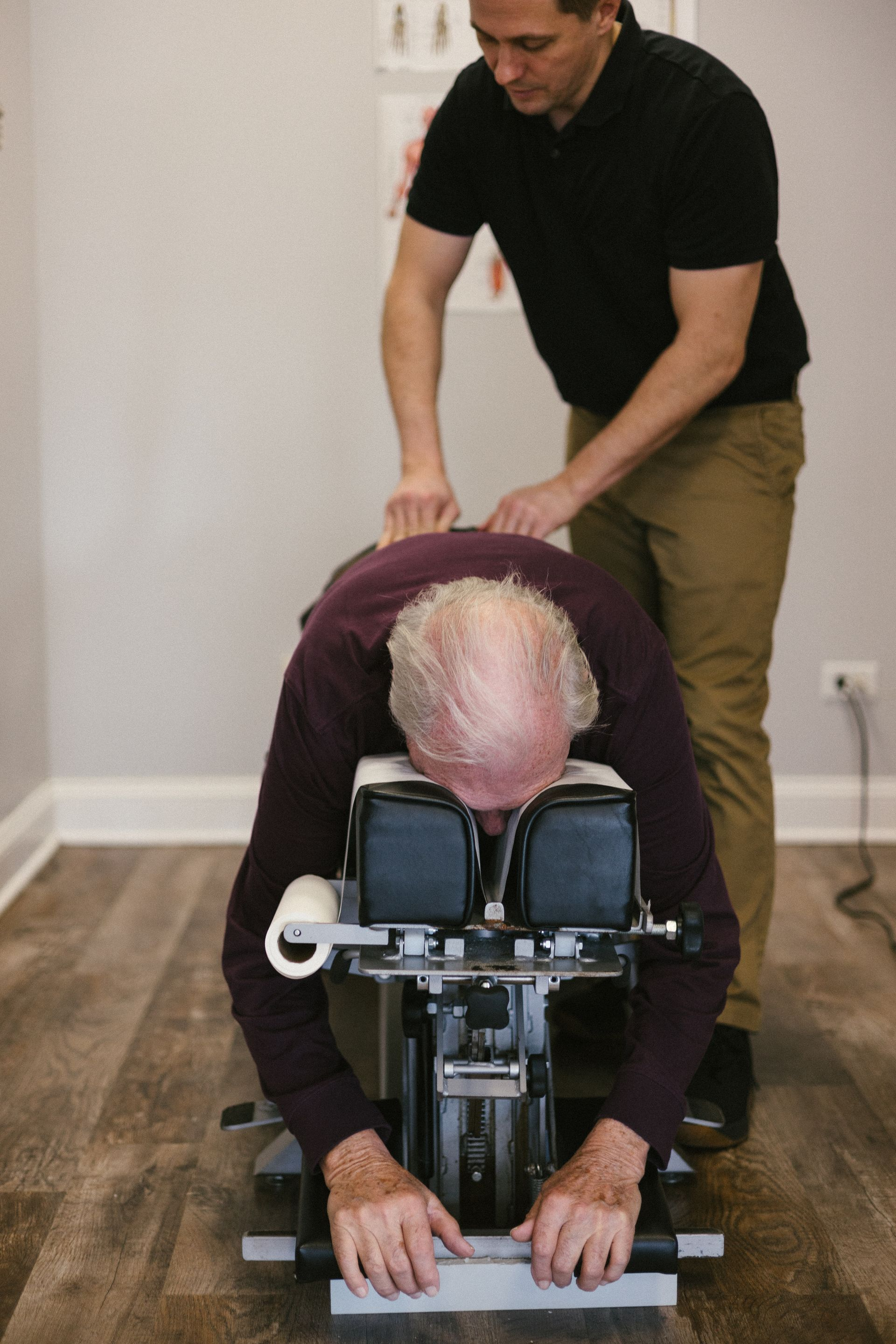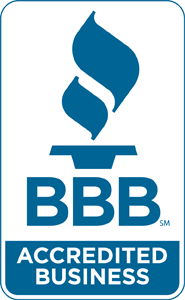Common Chiropractic Modalities Often Used
Louise Blankenship • June 9, 2019
Common Chiropractic Modalities Often Used

Although their main method of treatment is spinal manipulation, many chiropractors also use other therapies to treat their patients. Some of the most common treatments chiropractic doctors
recommend includes therapeutic exercise and stretching, spinal traction, manual soft tissue therapy, transcutaneous electric nerve stimulation (TENS), ultrasound, and others.
Modalities are defined as “Any physical agent applied to produce therapeutic changes to biologic tissues; includes but not limited to thermal, acoustic, light, mechanical, or electric energy.” They can be attended OR non-attended.
Common Chiropractic Modalities
- Ultrasound. Therapeutic ultrasound is a form of deep heat therapy created by sound waves. When applied to soft tissues and joints, the sound waves are a form of micro-massage that help reduce swelling, increase blood flow, and decrease pain, stiffness, and muscle spasms.
- Heat and cold. Chiropractors may alternate between heat and ice therapy to help patients treat back pain. Ice packs may be used to numb the back for a 10 to 15 minute period and then switched with a heating pad, heat wrap or hot water bottle to restore blood flow to the area and promote faster healing.
- Massage and Soft Tissue Mobilization. Massage is defined as the rubbing and kneading of muscles and joints by the hands especially to relieve tension. Soft tissue mobilization is a specific assessment, evaluation, and treatment of soft tissues (ligaments, muscles, tendons, and fascia) for the purpose of creating beneficial effects on the nervous, musculoskeletal, lymph, and circulatory systems.
- Therapeutic Exercise. Chiropractors commonly prescribe specific strengthening exercises for their patients with back, neck, and extremity problems. These exercises can help decrease pain, prevent muscle deterioration, promote joint health, increase strength, stability, and range of motion, and protect against new or recurring injuries.
- Spinal Traction. Many chiropractors use spinal traction, in which traction devices are applied to distract areas of the spine. This treatment helps to gently separate the vertebrae resulting in disc decompression, reduced nerve root pressure, and less pain.
- Dietary management. Many chiropractors will provide patients with tips on how an improved diet may help with their back pain, and some may recommend dietary supplements after spinal manipulation.
- Cold Laser. Unlike standard lasers, the cold laser produces light without heat. That makes it a worthwhile piece of equipment for treating injured areas and encouraging cell function and healing. For some injuries, heat can make the situation worse. That’s not true of cold lasers.
- Transcutaneous Electric Nerve Stimulation (TENS). A TENS unit is a small, battery-powered, portable muscle stimulation machine that can be used at home to help control pain. Variable intensities of electric current are used to control pain. This treatment is recommended to help patients get through periods of severe (acute) pain.
- Interferential Current. Interferential current (IFC) is another type of TENS therapy. This mode uses high-frequency electrical impulses to reduce pain deep within a patient’s tissue. For sensitive patients, IFC is a good substitute, since the high frequency meets less skin resistance than a TENs unit.
- Lifestyle Changes. Good health is much more than the absence of pain or disease. The lifestyle choices you make on a daily basis can greatly affect your long-term health. Your chiropractor can talk to you about your lifestyle choices, help you sort through and identify unhealthy health habits, and give you practical strategies to deal with and manage them
The Takeaway
As you can see, chiropractic medicine is more than just spinal manipulations. Chiropractors use a variety of treatment modalities to help the body to heal itself and return the patient to a pain-free and healthy life.
Chiropractic Care
is what happens when science and art come together in the hands of a knowledgeable, concerned physician. The spinal column is inherently important to the body’s overall health. Contact us to learn more and to view our services!

Celebrating Deaf Awareness Month: A Commitment to Communication and Wellness September is Deaf Awareness Month, a time dedicated to celebrating the rich culture, language and contributions of the Deaf and Hard of Hearing community. Here at Family Chiropractic Plus, we see this as more than just an observance; it’s a powerful reminder that true health and wellness are built on a foundation of clear communication, understanding and inclusivity. Communication is the bridge that connects us. In healthcare, that bridge is essential. When communication is clear, accessible and respectful, patients feel seen, heard and empowered. For members of the Deaf community, navigating a world that primarily communicates through sound can present significant barriers, especially in a healthcare setting. We believe it is our responsibility to help break down those barriers. Our Commitment to the Deaf Community in St. Petersburg Our mission at Family Chiropractic Plus is to help you become the very best version of yourself, and that promise extends to every member of our community. We are committed to providing a welcoming, accessible and supportive environment for our Deaf and Hard of Hearing patients. We understand that effective communication is key to your care. Our team is dedicated to: • Ensuring We Understand You: We are prepared to utilize various communication methods, including writing, visual aids, and are happy to work with Video Remote Interpreting (VRI) services or a patient-provided ASL interpreter to ensure consultations are clear and comfortable. • Providing Patient-Centered Care: We take the time to listen, ensuring you are a full partner in your healthcare journey. Your comfort and understanding are our top priorities. • Creating a Safe Space: We are dedicated to fostering an environment of respect and patience, where every individual feels valued and understood. Wellness is for Every Body Just as your nervous system is the communication highway for your body, clear communication is the pathway to holistic wellness. Chiropractic care helps ensure your body's internal communication lines are functioning optimally. In the same spirit, we strive to ensure our communication with you is just as clear and effective. This Deaf Awareness Month, we celebrate the strength and vibrancy of the Deaf community. We also reaffirm our commitment to being a healthcare partner you can trust. Your journey to health starts with being understood. Contact our St. Petersburg clinic today to learn more or to schedule your appointment.

Here in St. Petersburg, we love our active lifestyle, from walking the pier to enjoying our beautiful beaches. But for the over 100 million Americans who experience chronic pain, daily life can be a significant challenge. According to a recent Institute of Medicine report, chronic pain affects more people than diabetes, heart disease, and cancer combined. Living with pain is debilitating. At Family Chiropractic Plus, we believe that understanding the underlying causes of pain is the first step toward finding effective relief. September is Pain Awareness Month; an initiative started in 2001 to educate the public about this widespread condition. In an effort to bring awareness to our community, we've gathered 10 essential facts about pain. 1. Pain is the #1 cause of disability in the United States. Pain causes more long-term disability than cancer and heart disease combined. The number of sufferers is staggering, with 100 million Americans living with chronic pain. 2. Your attitude can affect your pain. Research from Oregon Health and Science University found that individuals who have a proactive attitude and seek ways to cope with their pain tend to have better outcomes than those who focus on the pain itself. This is why a holistic approach that includes managing the mental and emotional aspects of pain is so important. 3. One in three people is personally affected by pain. More than 50 million Americans suffer from chronic pain each year, and another 25 million experience acute pain from an injury or surgery. It can affect anyone, but it is most common in adults aged 24 to 64. 4. Women may experience pain differently than men. A 2005 study found that women tend to report more pain throughout their lifetimes compared to men. However, women also tend to seek treatment more quickly and often recover faster. 5. Pain is incredibly costly. Pain costs our country an estimated $560-$635 billion annually in lost workdays, medical expenses, and other benefits. That's about $2,000 for every person living in the U.S. 6. Pain is a top reason for doctor visits. After the common cold, back pain is the number one reason people visit their family doctor. A survey by Research! America found that while most sufferers (63%) see their family doctor, 40% also make an appointment with a specialist, such as an orthopedist or chiropractor. 7. Pain significantly affects the workforce. The American Productivity Audit found that workers with a pain condition lose an average of 4.6 hours of productive time each week. An estimated $61.2 billion per year is lost, not from absenteeism, but from reduced performance at work. 8. Smoking can make pain worse. Studies show that smoking increases your risk of developing back pain and can intensify chronic pain for those with conditions like fibromyalgia. The pain is often reported as more intense in smokers than in nonsmokers. 9. Pain disrupts sleep. An estimated 20% of American adults report that pain disrupts their sleep a few nights a week or more. This creates a difficult cycle, as lack of sleep can interfere with mood, healing, and overall quality of life. 10. The weather can affect pain. You're not imagining it! Changes in barometric pressure, especially common here in Florida, can cause increased joint pain for some people, particularly those with arthritis. Find Relief at Family Chiropractic Plus There are many effective treatments available for both acute and chronic pain. This month, help create awareness by sharing this information and learning more about the advanced, non-invasive options that can help you or your loved ones find relief. If you are living with pain here in the St. Petersburg area, you don't have to suffer in silence. The team at Family Chiropractic Plus is here to help you find the root cause of your pain and create a personalized plan to help you reclaim your life. Contact us today to schedule your appointment.

While many people associate chiropractic care with back and neck pain, its benefits extend much further. One of the most common yet often overlooked conditions we help manage at Family Chiropractic Plus is arthritis. This condition, which causes joint pain, swelling, and stiffness, can significantly impact your quality of life, but you don't have to manage it alone. Understanding Arthritis Arthritis is a condition that affects joint health, and its symptoms typically worsen with age. If you're experiencing any of the following, you might be dealing with arthritis: • Pain and tenderness in your joints • Stiffness, especially in the morning • Swelling, inflammation, or redness • A feeling of weakness or buckling in the joint • Decreased range of motion You are not alone. Millions of Americans live with some form of arthritis, from osteoarthritis to rheumatoid arthritis. This condition can prevent you from enjoying your favorite hobbies, working comfortably, and living the active St. Petersburg lifestyle you love. Before turning to more medication, consider a less-invasive and highly effective treatment: chiropractic care. How Chiropractic Care Helps Arthritis At Family Chiropractic Plus, we look beyond just the symptoms to address the root cause of your joint pain. Studies show that chiropractic care is a safe and effective way to treat joint pain and reduce inflammation. Types of Arthritis We See • Osteoarthritis: The most common form, affecting the flexible cartilage of the joints. • Rheumatoid Arthritis: A chronic autoimmune disorder that targets the joints. Routine chiropractic care can benefit both forms of the condition. Our pain management strategies, combined with non-invasive treatments, can help you find relief without long-term reliance on painkillers. Our Methods of Chiropractic Treatment Every person’s experience with arthritis is unique. We develop a holistic treatment plan that addresses your specific pain points while improving your overall mobility and strength. Our techniques include: • Extremity Joint Mobilization: We gently work with the joints in your hands, wrists, feet, and knees to identify restricted areas and improve your mobility. • Chiropractic Adjustments: By correcting misalignments, we can reduce restrictions not just in the affected joints but throughout your body, which helps lower overall inflammation. We also offer other supportive treatments to enhance your care, such as massage therapy, heat/cold therapy, and personalized physical therapy exercises. Common Questions About Chiropractic Care for Arthritis Seeking treatment is the first step toward relief. Here are answers to some common questions we hear from our St. Petersburg patients. Is Chiropractic Care Safe for Arthritis? Yes. For osteoarthritis, chiropractic care is one of the safest treatment methods available. For inflammatory conditions like rheumatoid arthritis, we are still able to provide safe and effective care, though we may modify our techniques. We will never adjust a joint that has active, swollen inflammation. Instead, we can work on the surrounding tissues and muscles to relieve tightness and pain. Can a Chiropractor Help With Arthritis in the Lower Back? Absolutely . Spinal manipulation is one of our primary services. By gently realigning the spine, we can relieve pain and tension in the lower back. These adjustments also improve overall joint health, increase mobility, loosen tight muscles, and can even boost your energy and sense of well-being. How Often Will I Need to See a Chiropractor? Many patients feel significant relief after their first visit. However, consistent, regular visits are typically the most effective for managing pain and healing the body over time. The frequency of your visits will be tailored to your specific condition and goals, which we will discuss with you. Start Your Journey to Relief at Family Chiropractic Plus If arthritis pain is affecting your life, don't let it hold you back any longer. Chiropractic care at our St. Petersburg clinic won’t just help you manage your pain day-to-day—it can help improve your joint function and slow the progression of your arthritis over time. Contact Family Chiropractic Plus today to schedule your appointment and learn more about our arthritis treatment options.

When the intense summer heat gives way to the milder days of fall here in Florida, it's the perfect time to refocus on your health and flexibility. This seasonal shift often changes our routines—perhaps we're less active outdoors or spending more time sitting. This can lead to increased stiffness and discomfort. At Family Chiropractic Plus, we believe that staying flexible is essential for your overall wellness, and combining chiropractic care with targeted stretches can help you feel your best all season long. Why Does Flexibility Matter? Flexibility is more than just being able to touch your toes. It’s crucial for maintaining a healthy spine, reducing your risk of injury, and improving your mobility. As we get older, our muscles naturally become less elastic. Daily activities, like sitting at a desk for hours, can lead to significant tightness and pain. By incorporating chiropractic care and simple flexibility exercises into your routine, you can improve your range of motion and release tension throughout your body. Chiropractor-Approved Stretches to Try This Fall Here are five simple stretches you can do at home or at the office to keep your body flexible and aligned. 1. Cat-Cow Stretch This is an excellent stretch for improving spinal flexibility and loosening tight back muscles. • How to do it: Start on your hands and knees. As you inhale, arch your back and lift your head and tailbone (Cow Pose). As you exhale, round your spine and tuck your chin to your chest (Cat Pose). Flow between these two poses for 10 repetitions. 2. Seated Hamstring Stretch Our hamstrings can tighten up when we're less active. This stretch helps increase flexibility in the back of your legs and your lower back. • How to do it: Sit on the edge of a chair with one leg extended straight, heel on the floor. Keeping your back straight, lean forward from your hips with your chest out until you feel a gentle stretch. Hold for 20-30 seconds, then switch legs. 3. Neck Stretch It’s easy for neck muscles to become stiff. This simple stretch targets the neck and upper spine. While sitting or standing straight, slowly tilt your head, bringing your ear toward your shoulder. You can use your hand to apply gentle pressure to deepen the stretch. Hold for 15-20 seconds and then switch sides. 4. Child’s Pose This restorative pose is fantastic for relieving tension in the lower back and shoulders while promoting hip flexibility. • How to do it: Start on your hands and knees, then sit your hips back toward your heels and extend your arms forward. Rest your forehead on the floor and breathe deeply. Hold for 30-60 seconds. 5. Hip Flexor Stretch Tight hip flexors are a common issue, especially for those who sit frequently. This stretch helps release that tension. • How to do it: Get into a lunge position with one foot forward. Keeping your chest up, gently press your hips forward until you feel a stretch along the front of your back hip. Hold for 20-30 seconds, then switch legs. Chiropractic Care and Stretching: The Perfect Combination Chiropractic adjustments and stretching work together perfectly. Our adjustments at Family Chiropractic Plus help correct misalignments that cause stiffness, while regular stretching helps you maintain that alignment, improve flexibility, and prevent future injuries. Tips for Staying Flexible All Season Long • Stay Consistent: Make stretching a daily habit, even for just a few minutes. • Hydrate: Drinking enough water is crucial for muscle health, especially as the weather changes. • Keep Moving: Avoid sitting for long periods. Get up and take short walks or stretch breaks throughout the day. Visit Family Chiropractic Plus in St. Petersburg This Fall Our team is here to help you feel your best with chiropractic adjustments, personalized stretching routines and overall wellness support. If you’re feeling stiff or experiencing discomfort as we move into fall, schedule an appointment with us. Together, we’ll create a plan to keep you flexible and pain-free.

Auto accidents are a stressful and overwhelming reality on St. Petersburg roads. Even in a seemingly minor fender-bender, the immediate focus is often on visible damage, but the true impact on your body may not surface for days or even weeks. Ignoring these delayed symptoms can lead to chronic pain and long-term issues that affect your mobility and quality of life. At Family Chiropractic Plus, we specialize in uncovering and treating the hidden injuries from auto accidents to ensure your recovery is both thorough and effective. Here’s why it's crucial to pay attention to delayed symptoms and how our dedicated chiropractic care can help you heal correctly. Why Pain and Symptoms Are Often Delayed Immediately after a car accident, your body's natural "fight or flight" response kicks in, flooding your system with adrenaline and endorphins. These powerful hormones are natural painkillers that can mask the severity of an injury, making you feel fine when you're not. Once these hormones subside, the physical trauma from the crash begins to reveal itself. Common delayed symptoms to watch for include: • Neck or shoulder pain and stiffness, which are common signs of whiplash. • Persistent headaches or migraines. • Low back pain, ranging from a dull ache to sharp, shooting pain. • Numbness or tingling in your arms, hands, legs, or feet. • Unexpected fatigue, dizziness, or difficulty concentrating. These symptoms often indicate underlying issues like soft tissue damage, spinal misalignments, or nerve irritation that require professional evaluation. The Dangers of "Waiting It Out" Hoping that pain will simply go away on its own is a significant risk. Delaying proper treatment can allow acute injuries to become chronic conditions. • Untreated whiplash can lead to persistent neck pain, chronic headaches and degenerative changes in the spine. • Minor back injuries can worsen over time, causing ongoing discomfort and limiting your ability to enjoy daily activities. • Nerve irritation or damage can progress, leading to lasting numbness, weakness or radiating pain. Addressing these issues early is the key to preventing long-term complications and ensuring a faster, more complete recovery. How Chiropractic Care at Family Chiropractic Plus Can Help Our team offers a non-invasive and highly effective approach to treating auto accident injuries. We focus on identifying the root cause of your symptoms and developing a personalized treatment plan to help your body heal naturally. Your care plan may include : • Gentle Spinal Adjustments: To correct structural misalignments in the spine and joints caused by the accident's impact, relieving pressure on nerves. • Advanced Soft Tissue Therapy: To reduce inflammation, break down scar tissue, and promote healing in injured muscles, ligaments, and tendons. • Onsite Digital X-Rays: To provide a clear diagnosis, rule out serious complications, and allow us to create a highly specialized treatment plan tailored to your specific injuries. • Customized Rehabilitation Exercises: To restore your body's strength, improve mobility, and stabilize the injured areas to prevent re-injury. • Consistent Progress Monitoring: To track your healing journey and make any necessary adjustments to your care plan along the way. If you’ve been in a car accident in the St. Petersburg area, don't wait for pain to become a problem. Early intervention can save you from months or years of discomfort. 1. Get a professional evaluation as soon as possible, even if you feel fine. 2. Keep a simple log of any new or changing symptoms you experience. 3. Schedule a consultation with our team at Family Chiropractic Plus to get a clear diagnosis and a personalized recovery plan. Your Recovery Starts Here At Family Chiropractic Plus, we are here to guide your recovery and prevent long-term issues from disrupting your life. Delayed symptoms are your body's way of asking for help—and we're here to listen. Contact our St. Petersburg office today to schedule your consultation and start your path to feeling better. Your health is our priority.

Here in St. Petersburg, when people think of chiropractic care, they often focus on spinal adjustments and improved posture. While these are the cornerstones of what we do at Family Chiropractic Plus, we've seen firsthand how the benefits can be dramatically amplified when combined with massage therapy. The synergy between these two powerful treatments enhances healing, restores mobility, and supports your long-term wellness goals. Let’s explore how chiropractic care and massage therapy work hand in hand to help you feel your absolute best. The Perfect Partnership for Your Health Think of it this way: our chiropractic care focuses on the structure—your spinal alignment and nervous system function—ensuring your body's "wiring" is clear and efficient. Massage therapy, in turn, addresses the "soft wiring"—your muscles, tendons, and ligaments—by reducing tension, improving blood flow, and promoting deep relaxation. When we bring these therapies together, we create a comprehensive approach that supports your body's incredible ability to heal and thrive. Key Benefits of Integrating Massage with Your Chiropractic Care • Prepares Your Body for Better Adjustments: When your muscles are tense and tight, they can resist spinal adjustments. A massage beforehand helps relax these soft tissues, making your chiropractic adjustments smoother, more comfortable, and ultimately more effective and long-lasting. • Accelerates Healing and Reduces Inflammation: The improved circulation from massage therapy is crucial. It helps deliver a rich supply of oxygen and vital nutrients to your tissues while flushing out inflammatory byproducts, significantly speeding up your recovery process. • Increases Flexibility and Restores Range of Motion: If you're struggling with stiffness or restricted movement, this combination is for you. Massage works to release muscle knots and adhesions, while chiropractic adjustments restore proper joint mechanics. The result is a body that moves more freely and with less pain. • Provides Powerful Pain Relief: Whether you're dealing with a nagging injury, chronic back pain, or persistent headaches, combining these treatments can offer profound relief. Chiropractic adjustments address the root structural cause, while massage soothes the sore, spasming muscles that contribute to your discomfort. • Deepens Relaxation and Melts Away Stress: Your nervous system is central to your health. While our chiropractic care removes nerve interference, massage therapy helps calm your body's stress response, lowering stress hormones and creating an optimal state for healing and relaxation. Who in St. Petersburg Can Benefit from This Combined Approach? We find this integrated approach is especially helpful for: • Patients with chronic conditions like back pain, neck pain, sciatica, or frequent headaches. • Athletes aiming to recover from injuries faster or enhance their performance. • Individuals dealing with high-stress jobs or tension-related discomfort. • Anyone struggling with postural imbalances from sitting at a desk or from daily activities. Maximize Your Wellness at Family Chiropractic Plus If you’re already a patient with us or are considering chiropractic care, incorporating massage therapy can take your results to the next level. At Family Chiropractic Plus, we are committed to providing a comprehensive, holistic path to health for our St. Petersburg community. We will work with you to create a personalized care plan that integrates both therapies for the best possible outcome. Are you ready to experience the incredible benefits of combining massage and chiropractic care? Contact Family Chiropractic Plus in St. Petersburg today to schedule your appointment. Let's work together to get you on the path to better movement, lasting pain relief, and a healthier, more vibrant life!

As pet parents, we’d do anything to ensure our furry family members live their happiest, healthiest lives. We diligently schedule vet check-ups, provide nutritious food and offer endless belly rubs. But what if there was another gentle, effective tool to add to their wellness toolkit? What if subtle signs of discomfort—like hesitation on the stairs or less enthusiasm for fetch—could be addressed through a hands-on approach that supports their body's natural healing ability? Enter the world of animal chiropractic care, a holistic therapy focused on restoring mobility, alleviating pain and boosting your pet's overall quality of life. What is Animal Chiropractic Care? Just like in humans, your pet's nervous system controls everything in their body. It's the master communication network, sending signals from the brain, down the spinal cord and out to every organ and muscle. The spine acts as the protective armor for this vital highway. When vertebrae in the spine become slightly misaligned or restricted in their movement—a condition known as a subluxation—it can interfere with the flow of information along those nerves. This can lead to pain, stiffness, muscle tension, and even affect organ function. Animal chiropractic care involves a certified Doctor using their hands to apply a gentle, specific, and quick thrust to a joint to restore its normal motion. The goal is simple: to remove the interference in the nervous system, allowing the body to function and heal as it was designed to. The Tail-Wagging Benefits of an Adjustment So, what kind of positive changes might you see after your dog or cat visits a chiropractor? The benefits are surprisingly wide-ranging. 1. Improved Mobility and Pain Relief This is one of the most common reasons pet owners seek chiropractic care. Adjustments can provide significant relief for animals suffering from: • Arthritis • Hip dysplasia • Joint stiffness and general "slowing down" • Neck or back pain • Recovery from injuries or surgery By restoring proper joint mechanics, chiropractic care can reduce inflammation and pain, helping your senior dog navigate the house with ease again or encouraging your cat to leap onto their favorite perch without hesitation. 2. Enhanced Nervous System Function Since the nervous system governs everything, a well-aligned spine supports whole-body health. Proper nerve flow can improve biomechanics and coordination, which is crucial for active and athletic dogs. It can also have a positive impact on issues that might not seem related to the spine, such as certain types of incontinence or digestive problems, by ensuring the organs are getting the right signals from the brain. 3. Support for Senior Pets The golden years can be tough on a pet's body. Chiropractic care is a wonderful, non-invasive way to manage chronic pain and maintain a high quality of life for senior animals. Regular adjustments can keep them more comfortable, mobile and engaged in family life for longer. 4. Proactive Wellness and Performance You don’t have to wait for a problem to arise. For canine athletes involved in sports like agility, flyball or dock diving, regular chiropractic check-ups can help prevent injuries, improve flexibility and ensure they are performing at their peak. Think of it as essential maintenance for your high-performance companion. Signs Your Pet Might Benefit from a Visit Our pets can't tell us when they're sore. Instead, they show us through subtle changes in their behavior and movement. Keep an eye out for these signs: • Difficulty getting up from a lying position • Hesitation to jump on furniture, into the car, or go up/down stairs • Changes in posture (e.g., a roached back or sitting on one side) • Yelping or sensitivity when being touched or lifted • Limping or an unusual gait • A decline in performance or a lack of enthusiasm for play • Licking or chewing at a specific area of their body repeatedly What to Expect A visit to an animal chiropractor is a calm and gentle experience. The practitioner will start by taking a detailed history of your pet's health and lifestyle. They will then perform a thorough examination, observing your pet's gait and posture and using their hands to feel the spine and joints for areas of restriction. The adjustment itself is very quick and precise. Most animals don't even seem to notice it, and many find the process relaxing. Owners are often surprised at how gentle it is. If you've noticed your four-legged friend slowing down or showing signs of discomfort, it might be time to look beyond conventional treatments. Animal chiropractic care offers a safe, effective and holistic path to restoring movement, relieving pain and unleashing your pet's inner puppy or kitten once again. Call Family Chiropractic Plus to find out if a consultation could be the right next step for your beloved companion.

For many, a visit to the chiropractor is a reactive decision. A sudden twinge in the lower back after lifting a heavy box, a persistent crick in the neck from a long week at the desk, or headaches that just won't quit. We often wait for pain to become the primary motivator for seeking care. But what if we shifted our perspective? What if, instead of just treating problems as they arise, we could actively prevent them from happening in the first place? This is the central idea behind a growing movement in healthcare: proactive wellness. And within this model, chiropractic care is emerging as a powerful cornerstone strategy for maintaining long-term health, not just alleviating immediate pain. It's about moving from a "pain-based" model to a "wellness-based" one, where the goal is to keep you functioning at your absolute best, day in and day out. Redefining the Role of Your Chiropractor The common perception of chiropractic care often revolves around the signature "adjustment" or "manipulation " that provides relief. While these spinal manipulations are a key technique, their purpose runs much deeper than a temporary fix. Your spine is the central highway for your nervous system, which controls and coordinates every single function in your body—from muscle movement to organ function. When vertebrae in the spine are misaligned (a condition known as a subluxation), they can interfere with this critical nerve communication. A proactive approach to chiropractic care focuses on identifying and correcting these minor misalignments before they lead to pain, dysfunction, or injury. Think of it like a dental check-up or routine car maintenance; you go regularly to prevent cavities and engine failure, not just when you have a toothache or your car breaks down. The Pillars of Preventative Chiropractic Care Leveraging chiropractic as a preventative tool can have a profound impact on your quality of life. Here are the keyways regular care helps you stay ahead of health issues: 1. Improving Posture and Combating "Tech Neck" In our modern world, we spend hours hunched over computers, craning our necks to look at smartphones, and slumping on couches. This chronic poor posture puts immense strain on the muscles and ligaments of the neck and spine, leading to the ubiquitous "tech neck," tension headaches, and upper back pain. Regular chiropractic adjustments help counteract these forces, realigning the spine and retraining your body to maintain better posture naturally. This reduces daily wear and tear, leaving you with more energy and less chronic discomfort. 2. Enhancing Athletic Performance Athletes at all levels, from weekend warriors to professionals, are increasingly turning to chiropractic care to gain a competitive edge. Optimal performance relies on flawless biomechanics. A properly aligned spine ensures that the nervous system is firing messages to muscles with maximum efficiency. This can lead to improved flexibility, greater power, a better range of motion, and enhanced balance and coordination. 3. Reducing the Risk of Injury Many injuries are not the result of a single event, but rather the culmination of minor, unaddressed imbalances. A slight misalignment in the pelvis can alter your gait, putting undue stress on a knee or ankle. A stiff mid-back can force the lower back and neck to overcompensate, making them vulnerable to sprains and strains. Proactive chiropractic care is like performing a regular systems check on your body's framework. By correcting these underlying imbalances, you create a more stable and resilient structure that is far less susceptible to injury during sports, work, or daily activities. Your Proactive Toolkit: Ergonomics for the Modern Workforce Your chiropractor is your partner in wellness, but a truly proactive approach includes how you manage your body between visits. Here are some essential ergonomic tips: • Optimize Your Desk: Position your monitor so the top of the screen is at or slightly below eye level. Your chair should allow your feet to rest flat on the floor with your knees at a 90-degree angle. Keep your keyboard and mouse close to avoid over-reaching. • Stand Up Straight: If you use a standing desk, ensure it's at a height where your elbows are bent at 90 degrees. Wear supportive shoes and consider an anti-fatigue mat. • Mind Your Mobile: Instead of looking down at your phone, consciously lift it closer to eye level. • Commute Comfortably: Adjust your car seat to support your lower back's natural curve and ensure you aren't straining to reach the pedals or steering wheel. Lifestyle Tips for a Resilient Spine Beyond the office, simple daily habits can make all the difference: • Move Every 30: Set a reminder to get up, stretch, and walk around for a few minutes every half hour. • Hydrate for Your Discs: The gelatinous discs between your vertebrae are mostly water. Staying well-hydrated keeps them healthy and pliable. • Sleep Smart: Sleep on your back or side, not your stomach. Use a supportive pillow that keeps your head in a neutral position with your spine. • Lift with Your Legs: When lifting anything, bend at your knees and hips, keeping your back straight and engaging your core muscles. Take the Driver's Seat of Your Wellness Becoming a proactive patient means seeing your health as your greatest asset. It's an investment in a future with more mobility, less pain, and a higher capacity to enjoy the activities you love. Chiropractic care is not just a solution for back pain; it is a vital tool for building and maintaining a foundation of optimal wellness. If you're ready to shift from simply reacting to pain to proactively building a healthier life, consider consulting with a chiropractor. A conversation about your health goals can be the first step toward creating a personalized, preventative care plan that will serve you for years to come. We're here to support you every step of the way. Follow the link to make an appointment today https://www.familychiroplus.com/start or call and chat to our friendly staff.

If you're one of the approximately 20 million Americans living with neuropathy each year, you know firsthand how its debilitating symptoms can deeply affect your quality of life. This neurological condition, where damage to your peripheral nervous system causes a range of uncomfortable and often distressing sensations, can stem from various underlying health issues. While conventional medicine often turns to medication to manage symptoms, many people like you are seeking and finding real benefits with chiropractic care to address the root causes of neuropathic pain and discomfort. Your peripheral nervous system is vital, acting as the communication network between your brain and spinal cord (your central nervous system) and the rest of your body. When these crucial pathways are damaged or disrupted, you might experience tingling, numbness, burning, and weaknesses that are hallmarks of neuropathy. We understand that finding effective, lasting relief becomes a top priority, especially since these symptoms can worsen if not properly addressed. At Family Chiropractic Plus, we believe in a holistic and personal approach to managing your neuropathy. We focus on empowering your body's natural healing capabilities. Instead of just masking symptoms, our goal is to identify and address the potential underlying causes of your nerve dysfunction. This comprehensive strategy often includes gentle spinal adjustments, targeted therapeutic techniques, and supportive lifestyle recommendations, all designed to help improve your overall nervous system function and bring you comfort. How Our Chiropractic Care Addresses Your Neuropathy Our approach to your neuropathy is fundamentally different. We look beyond just the symptoms to understand how issues like spinal misalignments or other musculoskeletal problems might be contributing to nerve compression, inflammation, and dysfunction. This whole-body perspective aims to improve your nervous system's health by addressing the structural factors that could be irritating your nerves. A central part of our care involves gently restoring proper alignment to your spine and other joints. When vertebrae are out of place, they can put pressure on the delicate nerve roots exiting your spinal column. This pressure can interfere with normal nerve signals, leading to or worsening your neuropathic symptoms. Through precise, careful adjustments, we work to correct these misalignments, aiming to relieve that nerve compression and improve communication along your nerves. But our care for your neuropathy doesn't stop at spinal adjustments. We often incorporate other supportive therapies tailored to your needs. These might include specialized massage techniques to boost circulation to the affected areas, ultrasound therapy to help reduce inflammation, or gentle electrical stimulation to help manage pain and potentially encourage nerve function. What You Can Expect on Your Journey to Neuropathy Relief with Us Your journey with us will typically start with a comprehensive, unhurried initial consultation. This is our chance to truly listen and understand your experience – your symptoms, your medical history, and any treatments you've tried. We'll then conduct a thorough physical examination, which may include neurological tests, checking your range of motion, and gently assessing the affected areas. If needed, we might discuss imaging studies like X-rays or MRIs to get a clearer picture, especially if we suspect issues like disc herniation. Based on this complete understanding, we'll develop an individualized care plan specifically for you, focusing on your unique needs and what you hope to achieve. This plan will outline the recommended frequency of your visits, the types of adjustments and therapies we believe will help you most, and an idea of the timeline for improvement. We often begin with more frequent visits during an initial period of intensive care, then, as your symptoms improve, we'll gradually transition to less frequent maintenance care to help you sustain your progress. We promise to provide clear information about what your care will involve and what results you can reasonably expect. During your visits, you'll receive care tailored to your specific condition. Gentle spinal adjustments are usually at the heart of your treatment, where we apply precise, controlled force to specific vertebrae to help restore their proper alignment. These adjustments might be complemented by soft tissue therapies, electrical stimulation, ultrasound, or other methods chosen to reduce inflammation and support your nerve healing. We also believe in empowering you, so many of our chiropractors will guide you through specific stretches and strengthening exercises you can do at home to enhance your progress. Your active participation is key! Home care recommendations are an important part of our comprehensive approach to your neuropathy. We'll provide guidance on activities or positions to be mindful of, as well as exercises or stretches for you to do regularly. We might also discuss nutritional advice, stress management techniques, or ergonomic tips to support your overall nervous system health. By working together between your office visits, we believe you can accelerate your progress and achieve more lasting improvements in your neuropathic symptoms. We're here to support you every step of the way. Follow the link to make an appointment today https://www.familychiroplus.com/start or call and chat to our friendly staff.

How Chiropractic Care Can Help You Avoid Surgical Intervention Each year, more than 500,000 Americans undergo back surgery, a statistic that highlights the prevalence of spinal issues in our society. While surgical intervention is sometimes necessary, many patients are discovering that alternative approaches can effectively address their pain without the risks and recovery time associated with operations. Chiropractic treatment stands at the forefront of these non-invasive options, offering hope to those suffering from chronic discomfort and limited mobility. For individuals experiencing persistent neck or back pain following accidents, injuries, or due to degenerative conditions, exploring conservative treatment methods before committing to surgery makes practical sense. Chiropractic care focuses on natural healing processes, addressing the root causes of discomfort rather than merely masking symptoms. This approach not only provides relief but may also eliminate the need for surgical procedures altogether. Research increasingly supports the effectiveness of chiropractic interventions in preventing surgical outcomes. A notable study examining approximately 1,900 workers with back injuries over three years revealed striking results: among those who initially consulted surgeons, 42% eventually underwent operations, while only 1.5% of those who sought chiropractic treatment required surgery. These findings underscore the potential of chiropractic care as a viable alternative to invasive procedures. Whether you're dealing with acute pain from a recent injury or managing a chronic condition, understanding how chiropractic treatment can help prevent surgery empowers you to make informed decisions about your health journey. Let's explore the specific ways chiropractors address common issues that might otherwise lead to the operating room. Addressing Neck Pain Through Chiropractic Methods Neck discomfort represents one of the most common complaints bringing patients to chiropractic offices. This pain often stems from spinal misalignments or dysfunction that extends beyond the neck itself. Professional chiropractors recognize that cervical issues frequently connect to problems in other regions of the spine, creating a complex pattern of discomfort that requires comprehensive assessment. During initial consultations, chiropractors conduct thorough examinations to identify the underlying causes of neck pain. This diagnostic process involves evaluating posture, range of motion, spinal alignment, and sometimes imaging studies to develop a complete picture of the patient's condition. By understanding the root causes rather than focusing solely on symptoms, practitioners can develop targeted treatment strategies that address fundamental issues. Chiropractic approaches to neck pain typically incorporate various techniques tailored to individual needs. These may include gentle spinal adjustments to restore proper alignment, manual therapy to address soft tissue restrictions, and therapeutic exercises to strengthen supporting muscles. This multifaceted approach helps relieve pressure on nerves, reduce inflammation, and improve mobility without resorting to surgical intervention. Conditions responsive to chiropractic care include cervical disc injuries that don't require immediate surgery, whiplash resulting from auto accidents, facet joint sprains, and degenerative conditions affecting the neck vertebrae. Even patients who have been told surgery might be necessary often experience significant improvement through consistent chiropractic treatment, allowing them to avoid operations and their associated risks. Halting Spinal Degeneration Before Surgery Becomes Necessary The progressive nature of spinal degeneration makes early intervention crucial for preventing surgical outcomes. As individuals age, natural wear and tear affects spinal structures, potentially leading to bone spurs, decreased disc height, and compromised function. Without proper management, these changes can accelerate, eventually reaching a point where surgical intervention seems inevitable. Regular chiropractic maintenance plays a vital role in slowing this degenerative process. Through periodic adjustments, chiropractors help maintain optimal spinal alignment, reducing uneven pressure on vertebral discs and facet joints. This balanced distribution of forces allows tissues to function properly and receive adequate nutrition, supporting the body's natural healing mechanisms. Chiropractic care addresses several factors contributing to spinal degeneration. By improving joint mobility, treatments prevent prolonged compression that accelerates disc deterioration. Enhanced blood circulation delivers essential nutrients to spinal tissues while removing inflammatory waste products. Additionally, proper alignment reduces stress on supporting ligaments and muscles, creating an environment conducive to tissue health rather than breakdown. For patients already experiencing early signs of degeneration, such as occasional stiffness or minor pain, chiropractic intervention can be particularly valuable. These individuals often respond well to conservative care, experiencing improved function and reduced discomfort without resorting to surgical procedures. Even those with more advanced degeneration frequently benefit from chiropractic treatment as part of a comprehensive management approach. Treating Back Injuries Without Surgical Intervention Back injuries represent a leading cause of disability worldwide, affecting people of all ages and activity levels. Whether resulting from sudden trauma like falls or accidents, or developing gradually through repetitive strain, these injuries can severely impact quality of life. Many sufferers initially believe surgery represents their only hope for relief, unaware that chiropractic care offers effective alternatives. Chiropractors approach back injuries with a focus on comprehensive assessment and individualized treatment planning. The evaluation process identifies specific tissues involved, movement patterns affected, and contributing factors that might impede recovery. This detailed understanding allows practitioners to develop targeted interventions addressing the unique aspects of each patient's condition rather than applying generic solutions. Treatment protocols for back injuries typically combine several therapeutic approaches. Spinal adjustments restore proper alignment and movement patterns, reducing pressure on injured tissues. Spinal decompression techniques gently stretch the spine, creating negative pressure that allows herniated or bulging discs to retract. Soft tissue therapies address muscle imbalances and trigger points that contribute to pain and dysfunction. This integrated approach promotes natural healing without surgical risks. The effectiveness of chiropractic care for back injuries extends beyond immediate pain relief to address long-term function and prevention. By correcting biomechanical issues contributing to the original injury, treatments reduce the likelihood of recurrence. Patients also receive education about proper body mechanics, ergonomics, and exercises to support ongoing spinal health, empowering them to participate actively in their recovery process. Research Supporting Chiropractic as a Surgery Alternative Scientific evidence increasingly validates chiropractic care as an effective approach for preventing surgical interventions. Multiple studies demonstrate significant benefits for patients who choose conservative treatment before considering operations, particularly for common spinal conditions that frequently lead to surgery. The previously mentioned research examining workers with back injuries provides compelling evidence of chiropractic effectiveness. The dramatic difference in surgical rates—42% for those initially seeing surgeons versus just 1.5% for those consulting chiropractors—suggests that treatment approach significantly influences patient outcomes. This study, published in the respected journal Spine, represents just one example of growing research supporting non-surgical alternatives. Additional studies have examined specific conditions commonly leading to surgery. Research on lumbar disc herniations, for instance, has shown that many patients achieve substantial improvement through chiropractic care despite initially being considered surgical candidates. Similarly, investigations of spinal stenosis patients have demonstrated that conservative management often provides sufficient relief to avoid operations, even in cases with significant neurological symptoms. Cost-effectiveness analyses further support chiropractic care as a prudent first approach. When comparing overall healthcare expenditures, patients who begin with conservative treatments typically incur lower total costs, even accounting for cases that eventually require surgery. This economic advantage, combined with reduced risks and recovery time, makes chiropractic intervention an attractive option for both patients and healthcare systems seeking optimal outcomes. Comprehensive Chiropractic Approaches to Prevent Surgery Modern chiropractic care encompasses far more than the spinal adjustments commonly associated with the profession. Today's practitioners utilize diverse techniques and technologies to address complex conditions that might otherwise lead to surgical intervention, creating truly comprehensive treatment plans tailored to individual needs. Spinal manipulation remains a cornerstone of chiropractic practice, with various techniques available depending on patient needs. From gentle, low-force methods appropriate for seniors or acute conditions to more dynamic approaches for younger, athletic individuals, adjustments are customized to provide optimal benefits while ensuring patient comfort. These manipulations restore proper joint function, reduce nerve irritation, and promote natural healing processes. Beyond adjustments, chiropractors incorporate numerous complementary therapies to enhance outcomes. Therapeutic exercises strengthen supporting muscles and improve movement patterns. Soft tissue techniques address muscle imbalances and adhesions that contribute to pain. Modalities like therapeutic ultrasound and electrical stimulation reduce inflammation and accelerate tissue repair. Spinal decompression systems provide gentle stretching for disc-related conditions. This multimodal approach addresses all aspects of spinal dysfunction. Patient education represents another crucial component of comprehensive chiropractic care. By helping individuals understand their conditions and teaching self-management strategies, practitioners empower patients to participate actively in their recovery. This educational aspect extends to ergonomic recommendations, lifestyle modifications, and preventive measures that support long-term spinal health and reduce the likelihood of future problems requiring surgical intervention. Conclusion: Choosing the Conservative Path When facing spinal pain or dysfunction, exploring non-surgical options before committing to operations makes practical sense. Chiropractic care offers a conservative, evidence-supported approach that addresses the root causes of many common conditions while avoiding the risks, recovery time, and expenses associated with surgical procedures. The growing body of research supporting chiropractic effectiveness provides reassurance for those considering this path. From preventing spinal degeneration to treating acute injuries and managing chronic conditions, chiropractic interventions have demonstrated significant benefits across diverse patient populations. The dramatic difference in surgical rates between those who begin with chiropractic care versus those who initially consult surgeons speaks volumes about the potential for conservative management. For individuals experiencing neck pain, back discomfort, or reduced mobility, consulting with a qualified chiropractor represents a logical first step. Through comprehensive assessment and individualized treatment planning, these practitioners can determine whether your condition might respond to conservative care or truly require surgical intervention. In many cases, patients discover that chiropractic treatment provides the relief they seek without operations. Remember that choosing chiropractic care doesn't mean permanently ruling out surgery if truly necessary. Rather, it represents a prudent approach that explores less invasive options first, potentially saving you from unnecessary procedures while addressing your pain and dysfunction effectively. With proper chiropractic care, many patients find themselves on the path to recovery without ever needing to enter an operating room. Ready for exceptional chiropractic care? Contact Family Chiropractic Plus today at www.familychiroplus.com . Our dedicated team is committed to restoring your body's natural state of health and well-being through regular adjustments, offering comprehensive care to promote healing and support your overall health.



